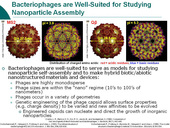Highlight
Self-Assembly of Well-Ordered, Close-Packed 2D Arrays of Recombinant Virus-Like Particles that Nucleate the Growth of Inorganic Nanomaterials
Achievement/Results
Due to their high degree of monodispersity, their highly symmetrical geometries, and the ease with which their protein capsids can be genetically engineered, bacteriophages are well-suited for use as templates in the spatially-defined self-assembly of inorganic materials into highly-ordered nanostructures. To this end, we have engineered virus-like particles (VLPs) of the 28-nm icosahedral bacteriophage, MS2, to express, at specific surface locations, non-native peptides that have been demonstrated to nucleate the growth of gold from an aqueous salt solution. We have characterized the affinity of VLPs displaying the gold-binding peptide in relation to unmodified VLPs and to VLPs displaying 90 cysteine residues using sodium dodecyl sulfate polyacrylamide gel electrophoresis (SDS-PAGE) and electron microscopy. We have used various deposition techniques, including convective assembly and interfacial assembly, to self-assemble recombinant VLPs into well-ordered hexagonal close-packed (HCP) monolayers, the long-range order of which was confirmed via Grazing Incidence Small-Angle X-ray Scattering (GISAXS) characterization at a synchrotron source. Convective assembly enables rapid deposition of colloidal particles onto a hydrophilic surface by trapping microliter-sized droplets between two fixed-angle plates and dragging the ensuing meniscus across a surface with constant velocity. In interfacial assembly, hydrophilic or hydrophobic colloids are self-assembled in an immiscible fluid-fluid interface into close-packed 2D arrays that can be easily transferred to a solid surface. Prior to reaction with the gold salt solution, we stabilized the VLP monolayers using either covalent attachment to a surface or immobilization in silica formed via sol-gel processing techniques. To covalently link VLPs to a surface, we employed self-assembled monolayers capable of bonding with primary amine or carboxylic acid-containing amino acid residues in the VLP capsid. To stabilize VLP monolayers within nanostructured silica, we have used traditional and biomimetic approaches. We first immobilized VLPs via evaporation-induced self-assembly of an acidified sol containing a pre-hydrolyzed silica precursor dissolved in a volatile solvent, but we found that the harsh conditions associated with traditional sol-gel techniques disrupted the three-dimensional structure of the VLP capsid. Therefore, we have created mosaic VLPs that display both the gold-binding peptide and the R5 peptide, which is found in proteins isolated from diatoms that catalyze silica condensation under neutral pH, biocompatible conditions. We have, furthermore, patterned surfaces with alternating hydrophobic and hydrophilic regions; phage particles selectively wet hydrophilic regions, enabling us to ultimately construct patternable gold nanoparticle-based devices with unique electrical and optical properties.
Address Goals
The research described here brings together a faculty member from the Biomedical Sciences Program (Prof. David Peabody) and from Chemical Engineering (Prof. C. Jeffrey Brinker) to do research on self assembly of cells in sol-gel media. This research became possible because the IGERT fellow Carlee Ashley who is getting her Ph.D. in Chemical Engineering did a rotation in Dr. Peabody’s lab. The work is significant because cells cannot be exposed to harsh conditions, and do not survive easily in inorganic scaffolds, but this work shows how self assembly routes can be used to develop novel sensing platforms.







